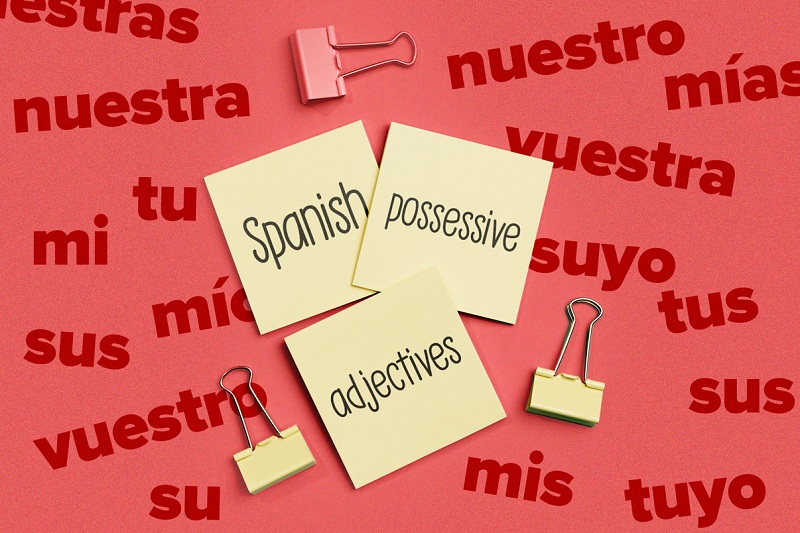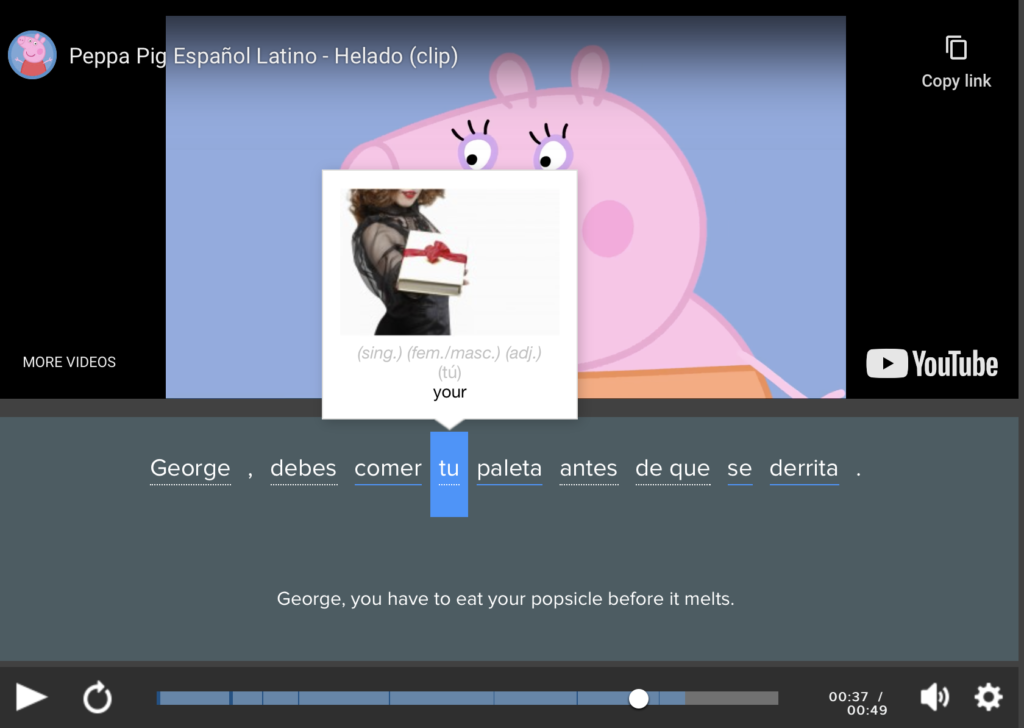
How to Use Spanish Possessive Adjectives (With Examples)
Imagine a world where you couldn’t talk about what’s mine, yours, ours, or theirs. It would be hard, right?
This is why possessive adjectives are so important, and it’s no different in Spanish!
Spanish has a few more forms of possessive adjectives than English, so brush up on your Spanish pronouns and genders and we can get started!
In this post, I’ll share everything you need to know about the different ways to express possession in Spanish. Then you’ll get to quiz yourself to see how much you’ve learned!
Contents
- What Are Possessive Adjectives?
- Short-form Spanish Possessive Adjectives
- Long-form Spanish Possessive Adjectives
- Notes on Spanish Possessive Adjectives
- Showing Possession in Other Ways
- Spanish Possessive Adjective Quiz
Download: This blog post is available as a convenient and portable PDF that you can take anywhere. Click here to get a copy. (Download)
What Are Possessive Adjectives?
Possessive adjectives, as the name suggests, are adjectives which are used to show who has possession of something.
The words “my,” “your,” “our,” “their,” etc. are all English possessive adjectives that show who something belongs to:
Where are my keys?
Let’s go to their house
Spanish possessive adjectives work similarly, with a few key differences in how they’re formed.
It’s important that you pay attention to the gender and the number of the thing being owned so that you use the proper adjective.
Short-form Spanish Possessive Adjectives
Here are the different Spanish possessive adjectives. Note that to make a singular adjective plural, you simply add s.
| English | Singular Possessive Adjective | Plural Possessive Adjective |
|---|---|---|
| My | Mi | Mis |
| Your (informal) | Tu | Tus |
| His/her/its/their/your (formal) | Su | Sus |
| Our | Nuestro
Nuestra | Nuestros
Nuestras |
| Your (informal plural) | Vuestro
Vuestra | Vuestros
Vuestras |
As you can see in the table, mi and tu as possessive adjectives don’t have accent marks. If you add accent marks to these adjectives, you would end up with different words: mí which means “for me,” and tú which means “you.”
Both nuestro and vuestro change based on the gender of the thing we own. It’s important to note that this has nothing to do with our genders, that is, the gender identities of the people who are owning something.
Nuestro teléfono — Our telephone
Vuestra casa — Your house
Mi, tu and su do not change for gender, so “his,” “her,” “their,” formal “your” and “its” are all the same word in Spanish: su.
Also remember that those plural possessive adjectives are used for when multiple things are owned, not when multiple people own something.
Example Sentences
Here are some examples of how these short-form possessive adjectives are used, keeping in mind that they always come before a noun.
Mi familia vive en los Estados Unidos. — My family lives in the United States.
Me gusta tu camisa. — I like your shirt.
¿Cuál es su dirección? — What’s your address?
Nuestro hijo es alto. — Our son is tall.
¿Cuál es el nombre de vuestro gato? — What’s your cat’s name?
Estos son mis libros. — These are my books.
¿Dónde viven tus hermanos? — Where do your siblings live?
Sus clases son muy interesantes. — Your classes are very interesting.
¿Dónde están nuestras cartas? — Where are our cards?
Vuestros zapatos están afuera. — Your shoes are outside.
Long-form Spanish Possessive Adjectives
Long-form Spanish possessive adjectives are, for the most part, reserved for things like older literature, poems, or songs.
No one uses this form in everyday speech nowadays—except for sentences about certain relationships, which are equivalent to the “[relationship] of [possessive]” structure in English, as well as in some other, very specific cases. For example:
Un amigo mío vive aquí. — A friend of mine lives here.
¡Madre mía! — Good heavens! (literally “Mother of mine!”)
Amigo mío, fue un placer verte. — My dear friend (literally “friend of mine“), it was a pleasure to see you.
But for the sake of completeness, we’re going to share them with you anyway.
Unlike short-form possessive adjectives, long-form possessive adjectives are used after nouns. They modify according to the gender and number of the thing being possessed, as follows:
| English | Masculine Singular | Feminine Singular | Masculine Plural | Feminine Plural |
|---|---|---|---|---|
| Of mine | Mío | Mía | Míos | Mías |
| Of yours (informal) | Tuyo | Tuya | Tuyos | Tuyas |
| Of his/hers/theirs/yours (formal) | Suyo | Suya | Suyos | Suyas |
| Of ours | Nuestro | Nuestra | Nuestros | Nuestras |
| Of yours (informal, plural) | Vuestro | Vuestra | Vuestros | Vuestras |
Example Sentences
Puedes usar un abrigo mío. — You can use a coat of mine.
Una amiga tuya llamó esta mañana. — A friend of yours called this morning.
Leí un libro suyo el año pasado. — I read a book of yours last year.
¿Viste una bicicleta nuestra por aquí? — Did you see a bike of ours around here?
¿Dónde están esos hijos vuestros? — Where are those kids of yours?
Son amigas mías del colegio. — They’re friends of mine from high school.
Las llaves tuyas están en la mesa. — Your keys are on the table. (Literally: The keys of yours are on the table.)
Conocí a unos colegas suyos. — I met some colleagues of yours.
Esas chicas son primas nuestras. — Those girls are cousins of ours.
Pongan esos cuadernos vuestros en el escritorio. — Put those notebooks of yours on the desk.
Notes on Spanish Possessive Adjectives
When to Avoid Possessive Adjectives
The most common mistakes made by English speakers with Spanish possessive adjectives actually involve using them too much!
Here are some situations not to use possessive adjectives:
- When you have a reflexive verb. If the action in question is already “going back” onto the subject (as with a reflexive verb) you don’t need a possessive adjective.
Me lavo las manos. — I’m washing my hands. (Literally: I’m washing myself the hands.)
- When talking about body parts. Don’t use possessive adjectives if you’re talking about parts of the body. Instead, use the definite article.
Se rompió la pierna. — She broke her leg. (Literally: she broke herself the leg.)
- If it’s not followed by a noun. In this case, you probably need a possessive pronoun instead.
¡Todo lo que ves aquí es mío! — Everything you see here is mine!
- If ownership is obvious. If it’s clear what (or who) belongs to who, there’s no need for a possessive adjective. For example if you’ve already mentioned that something belongs to you, or it can easily be assumed from the context.
Voy a ir al hotel. — I’m going to go to my hotel. (Literally: I’m going to go to the hotel.)
Repeating Possessive Adjectives
In Spanish you generally repeat the possessive adjectives when talking about more than one object that’s owned—in contrast to in English, where one possessive adjective is usually enough.
Son mis lápices y mis cuadernos. — They are my pencils and my notebooks.
The exception to this is when you’re using two nouns to describe the same actual thing.
Es mi amante y mejor amigo. — He is my lover and best friend. (talking about a single amazing person who fulfills these two functions)
Possessive Adjectives vs. Possessive Pronouns
It can be pretty easy to get mixed up between possessive adjectives and possessive pronouns in Spanish.
The simplest way to remember the difference is to recognize that possessive adjectives describe nouns, whereas pronouns completely replace them.
For example:
Mi gato es negro. — My cat is black.
El gato negro es mío. — The black cat is mine.
Note that the first sentence uses a possessive adjective (my cat) and the second sentence uses a possessive pronoun (the cat is mine).
If you want to know more about possessive pronouns, check out this post.
Showing Possession in Other Ways
Although possessive adjectives are probably the most straightforward way to demonstrate possession, they are not the only way that you can do this.
Showing Possession with Possessive Pronouns
As we already touched on, we can use possessive pronouns to show possession.
Note that the possessive pronouns are the same as the long-form possessive adjectives and have similar meanings.
Possessive pronoun: Ese perro es mío. — That dog is mine.
Long-form pronoun: Es un amigo nuestro. — He’s a friend of ours.
Showing Possession with De
Another way we can express possession is with the preposition de, which means “of,” but can be placed after a noun to express ownership.
This especially comes in handy where we’d usually use su, as it can be difficult to determine who exactly that word is talking about.
Here are some examples:
Es el artículo de Roberta. — It’s Roberta’s article.
Es el artículo de ella. — It’s her article.
Es el artículo de ustedes. — It’s your article.
If you want to see how possessive adjectives are used, you can try exposing yourself to Spanish conversation or media to watch how natives incorporate this element into their speech.
FluentU is a great resource for this as the program uses native video clips from movies, TV shows, etc. to show you how Spanish speaking natives demonstrate possession. 
You’ll even find tools like flashcards, interactive subtitles and flashcards to boost your learning. The program is offered on both iOS and Android.
Spanish Possessive Adjective Quiz
Now here’s your chance to put everything we’ve learned into practice!
Fill in the blanks with the correct Spanish possessive adjective, according to who is in possession and what they’re in possession of—i.e. the number (and in some cases, gender) of the object.
1. ¿Quieres venir a ___ casa en la tarde? (Do you want to come to my house in the afternoon?)
2. Él ama mucho a ___ novio. (He loves his boyfriend a lot.)
3. No es ___ problema. (It’s not our problem.)
4. Usted debe llamar a ___ jefe. (You should call her boss.)
5. ¿Qué pasó con ___ (informal) solicitud? (What happened with your application?)
6. No entiendo ___ (formal) acciones. (I don’t understand your actions.)
7. Extraño a ___ hijas. (I miss our daughters.)
8. ¿Has visto ___ lentes? (Have you seen my glasses?)
9. Confío en ___ (informal) palabras. (I trust your words.)
10. Me caen bien ___ amigos. (I like her friends.)
Answers:
1. ¿Quieres venir a mi casa en la tarde?
2. Él ama mucho a su novio.
3. No es nuestro problema. (Remember that problema is masculine!)
4. Usted debe llamar a su jefe.
5. ¿Qué pasó con tu solicitud?
6. No entiendo sus acciones.
7. Extraño a nuestras hijas.
8. ¿Has visto mis lentes?
9. Confío en tus palabras.
10. Me caen bien sus amigos.
I’m guessing you feel possessive over a few things in your life as well; now you should have the vocabulary to say so!
Download: This blog post is available as a convenient and portable PDF that you can take anywhere. Click here to get a copy. (Download)








